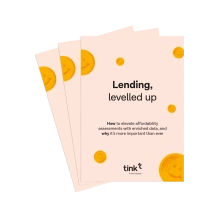Serving younger borrowers: the impact of inaccessible lending

Manual verification has the most impact on lenders’ operating costs, according to our new research. Capturing and authenticating application information is the largest cost for an estimated 25% of lenders. Meanwhile, the next generation of borrowers say they are willing to provide lenders with their financial data to secure loans.
New data from Tink suggests that cumbersome manual processes are detrimental to operating costs – 25% of lenders surveyed say document validation is their biggest expense
An estimated 32% of lenders say manual income verification is the most time-consuming step in their own risk decisioning
Data-driven risk assessment models could be a key solution as younger borrowers appear willing to provide their financial data to lenders
Our new research suggests that for lenders, cumbersome manual processes can be a costly and time-consuming element of their daily business. An estimated 32% of lenders cite manual income verification as the most time-consuming step in their own risk decisioning process. A quarter (25%) of survey participants say document validation – capturing application information and analysing its authenticity – is the largest expense they face.
Meanwhile, as consumers continue to navigate the cost-of-living crisis, our research also shows that younger age groups face significant barriers when it comes to accessing credit. According to our new survey of 1,000 UK borrowers, over three quarters (78%) of 18–34 year olds have had a loan application rejected. When asked why they’d been disqualified from a loan, 12% cited thin credit history – not having enough credit history to qualify – and 11% were rejected due to an inability to prove their financial history.
The effect of cumbersome processes on loan applications
Tink’s insights indicate that younger age groups are abandoning arduous applications, suggesting they have zero tolerance for friction-filled processes – and consequently, may not be capitalising on the financial services available to them.
The research shows that nearly a quarter (22%) of 18-34 year olds have abandoned a loan application – and used a different lender because the process was too cumbersome. What's more, when applying for a loan, 20% of respondents said they had the correct documents, yet abandoned the process due to having to manually submit them (e.g. printing and posting them).
A Tink survey of 200 UK lenders supports these findings with 36% of lenders surveyed citing manual income verification as the highest dropoff point in the loan application process.
Appetite for data-driven decision making
As a solution to overcome these barriers, younger age groups are willing to permit lenders to view transaction data from their bank accounts in return for smoother application processes and a better chance of securing a loan.
For example, encouragingly 40% of 18–34 year olds surveyed would allow lenders to digitally view their bank account transaction data to improve the application process (in other words, removing the need to manually submit documents on income and expenditure), while over half (57%) would like the option of having loans tailored to their financial situation (such as repayment plans which adapt to their monthly incomings and outgoings).
Additionally, the research highlights that lenders recognise that improving the loan application process makes sound business sense. More than three quarters (78%) of lenders surveyed agree it’s important to reduce friction in lending applications to gain a competitive advantage. 77% say improving risk decisioning models is crucial to a more accurate view of people’s finances.
“Our research highlights a clear access issue amongst younger generations trying to borrow. Not only are a significant amount wrestling with cumbersome application processes, they’re also being rejected for loans based on factors that suggest blinkered financial assessments," says Jack Spiers, Banking & Lending Director at Tink.
“It is important lenders are harnessing data-driven risk decisioning solutions to offer fair, accurate affordability checks, while also removing the friction associated with manual application submissions. And it’s not just benefiting the end user. Adopting these models can help lenders too – boosting customer acquisition through improved success rates, while reducing operational costs.”
Discover new ways to empower borrowers while future proofing your bottom line today. Get in touch to explore how our risk decisioning solutions can help you get ahead.

Lending, levelled up
A Tink white paper - How to elevate affordability assessments with enriched data.
Get the white paper—
About the research
Consumer research was conducted by Censuswide on behalf of Tink in September 2023, amongst 1,000 UK borrowers aged over 18 (i.e. those who currently have either a mortgage or a loan).
Lender research was conducted by Censuswide on behalf of Tink in September 2023 amongst 200 executives at a High street bank, Building society, Challenger bank, Payday lender or BNPL lender who have a decision-making role in the lending process.
Case studies, comparisons, statistics, research and recommendations are provided “AS IS” and intended for informational purposes only and should not be relied upon for operational, marketing, legal, technical, tax, financial or other advice. Visa Inc. neither makes any warranty or representation as to the completeness or accuracy of the information within this document, nor assumes any liability or responsibility that may result from reliance on such information. The Information contained herein is not intended as investment or legal advice, and readers are encouraged to seek the advice of a competent professional where such advice is required.
More in Open banking

2025-11-20
3 min read
Tink powers the UK’s first cVRP transaction with Visa A2A
In partnership with Visa, Kroo Bank, and Utilita, we’ve just helped demonstrate the UK’s first commercial variable recurring payment (cVRP) using the Visa A2A solution – and it’s a big step forward for how people make regular payments.
Read more

2025-06-09
11 min read
The case for “Pay by Bank” as a global term
Thomas Gmelch argues that "Pay by Bank" should be adopted as a standard term for open banking-powered account-to-account payments to reduce confusion, build trust, and boost adoption across the industry.
Read more

2025-06-02
3 min read
Tink joins Visa A2A – what it means for Pay by Bank and VRP
Visa A2A brings an enhanced framework to Pay by Bank and variable recurring payments (VRP) in the UK, and Tink is excited to be one of the first members of this new solution.
Read more
Get started with Tink
Contact our team to learn more about what we can help you build – or create an account to get started right away.
